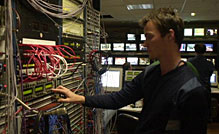
It is commonplace to think of innovation as being the result of the genius of individual ‘hero’ innovators, from Thomas Edison (electric light), Henry Ford (mass production) and Guglielmo Marconi (radio communications) to Akio Morita (Sony Walkman). This view was reinforced by the early work of Joseph Schumpeter, a leading researcher in innovation, who linked innovation with entrepreneurship and leadership, crediting innovators with almost superhuman characteristics – the visionary entrepreneur dreaming up new products and taking risks against all the odds.
This ‘hero’ view suggests that only gifted individuals can innovate. However, in his later work Schumpeter acknowledged the important role of organised R&D and corporate systems in managing innovation as a systematic activity. He lamented the declining contribution of the individual, due to the increasing routinisation and predictability of innovation: and corporate systems in managing innovation as a systematic activity:
"the romance of earlier commercial adventure is rapidly wearing away, because so many more things can be strictly calculated that had of old to be visualised in a flash of genius."
His reluctant faith in institutionalised innovation can now be seen as being only partly justified. Innovation today remains far from routine in many organisations.
Today, rather than being dependent on individual heroes, innovation has come to be seen as the result of complex interactions and systemic boundary-spanning activity, involving interdisciplinary groupings. The team can be seen as ‘hero’ and ‘collective entrepreneurship’ is seen to be based on distributed knowledge and groups working effectively. Studies of process innovations in Japanese manufacturing industry, that transformed manufacturing in terms of productivity and quality, showed the importance of ‘innovation on the shop floor’ – for example teams of engineers seeing ways to reduce delays and improve quality – rather than any select individuals or R&D labs.
The concept of the learning curve (also called the 'experience curve') is well established. Over time (or, perhaps more correctly, over the cumulative number of units produced), the cost of manufacturing a product declines. People work out how to create more efficient processes, shorten or eliminate production steps, and improve designs. The shape of the learning curve is sufficiently regular in many industries to enable the rate of improvement to be predicted for a given technology. The learning curve is an example of a quantifiably measurable learning behaviour for an organisation.
Nonetheless, the notion of the individual hero innovator persists, commonly in the guise of the individual ‘champion’ or entrepreneur ‘with exceptional qualities of drive, stamina and sheer bloody-mindedness’. Moreover, in some accounts innovation continues to be linked with leadership qualities.
Innovation literature throws further light on the factors that drive or trigger innovation. For the majority of managers, both product and process innovations are most often instigated by the need to solve existing problems. Indeed, a significant percentage of incremental innovation is driven by problem solving based on experiential learning by doing, learning by using and learning from failure. The latter point requires failed projects to be seen as opportunities for learning, rather than disasters that cannot be acknowledged or opportunities for blame. Incremental innovation may also be driven by the desire to reduce costs, or in response to customer demands.
A major programme of research into innovation and knowledge management is being carried out by the Open University Business School. One set of findings relates to barriers to innovation. Unsurprisingly, resource constraints are a major barrier, but beyond this, most of the factors identified were people related.
Examples include:
- people working in their narrow boxes (the silo mentality)
- fear of the consequences of failure (the blame culture)
- lack of perceived adequate rewards for the risk
- hoarding of the best people by unit managers
- people operating in a formal (bureaucratic) way
- 'not-invented-here' attitude (at the implementation stage)
- poor organisational communication
- reluctance to relinquish an erstwhile successful product
- technical obsession/insufficient customer orientation
- a ‘business-as-usual’ preference and priority over innovation
- short-termism – too strong an emphasis by key players on return on investment.

By far the greatest proportion of product and process innovations are incremental. For the most part, innovations contribute to performance improvement through many small incremental changes rather than through ‘big bang’ radical change. However, failure to be alert to the need for radical innovation can be dangerous. The vacuum cleaner market, for example, was marked by years of small incremental innovations until the emergence of the radically different Dyson vacuum cleaner resulted in dramatic loss of market share by incumbent firms.
Things going on outside an organisation are often drivers to innovation, such as competition, technical change, or regulatory changes, such as restrictions on pollution. Customer inputs to innovation (or ‘market pull’) have been observed for years. An ‘intelligent’ customer that makes demands and suggestions can be of great benefit. Those organisations that recognise and react to customer problems, or lapses in quality, are likely to have a strong drive for incremental innovation. The systematic searching for new ideas from customers may be a valuable source of information and ideas that drive innovation.
However, there is, paradoxically, a danger in listening too intently to current customers. They may not be able to see beyond the current product or service. Research has shown how previously innovative firms such as IBM and Xerox missed out on disruptive (or radical) innovations that had dramatic effects on their dominant market positions. Precisely because these firms listened to their customers, invested in new technologies that would provide their customers better examples of the existing products that they wanted, and because they carefully studied market trends and systematically allocated investment capital to innovations that promised the best returns, they lost their position of leadership.
It seems that the apparently good business practice of ‘listening to the customer’ may be appropriate as inputs to incremental innovation, but may leave your organisation dangerously exposed when radical innovations create a major discontinuity in the wider market. It is not surprising that this is described as the innovator’s dilemma.
Market demand is therefore only one driver. There is also the dynamic of technological development, which affects both suppliers and users of technology. Many studies have shown that new product innovation results from a new technological opportunity being coupled with market potential, rather than from specific customer demand. The Sony Walkman is an example of a product innovation based on perceptions of potential demand for a product that previously did not exist, coupled with the opportunities provided by electronic miniaturisation. Similarly 3M’s Post-it notes resulted from a developer of a technology (a non-permanent adhesive) seeking an application in a specific product for which there was no prior demand.
To achieve the necessary cost reductions, speed of response, and flexibility to enhance their potential for innovation, many organisations have had to restructure. Initially, companies tried to meet this challenge with more of the old strategies - downsizing and delayering, and divesting non-core business. Many companies have reorganised into more responsive structures by decentralising production to multidisciplinary teams, which are organized in product or service-related cells and divisions acting as their own profit centres. The new leaner twenty-first century organisation often finds development and growth now occurs through partnership and alliance with other companies, even old enemies, who can provide the necessary expertise or capital to compete.
About this article
This article is based on extracts taken from the Open University Business School courses: Strategy (B820), Managing Performance and Change (B700), Creativity, Innovation & Change (B822), Managing Knowledge (B823) and Making a Difference (B830).
Rate and Review
Rate this article
Review this article
Log into OpenLearn to leave reviews and join in the conversation.
Article reviews